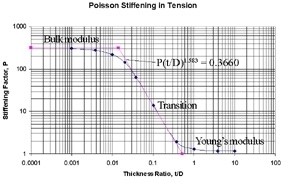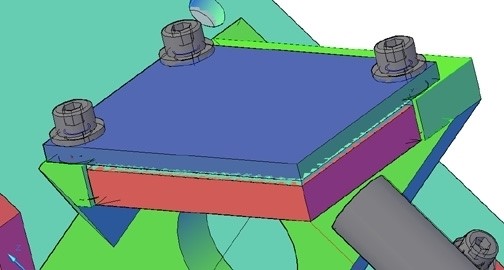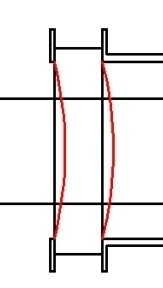Colleagues:
Let me revisit my engineering tool for adhesive mounting of mirrors:

Those of you who have studied the source
reference (SPIE: 6665-03, 2007) know now that it guides the engineer to
elastomeric adhesives for the mounting. The reason for this is that hard
adhesives have a high modulus of rigildity, G. This fact leads to large
optical distortions of the mirror surface due to differential thermal expansion
and contraction between the mirror and the mount. But, for elastomers
their low modulus of rigidity tends to isolate the mirror from the differential
expansion and contraction of the mount. The reduction in surface
distortion may be a factor of between two to three orders of magnitude using an
elastomer compared to a hard adhesive.

Simultaneously, Poisson stiffening tends to
stabilize the position of the mirror’s surface. It increases, by a
similar factor of 100 to 1,000, the apparent tension/compression modulus, K‘,
of the elastomer between the mirror and the mount (comparing K’ to the
Young’s modulus, E). The bulk modulus, K, for a silicone
elastomer is typically in the range of 150,000 psi to 200,000 psi whereas its
modulus of rigidity may be as low as 180 psi to 200 psi. In thin adhesive
layers the apparent tension/compression modulus, K’, approaches the bulk
modulus, K. Since the Young’s modulus would be about 570 psi,
which becomes a Stiffening Factor of about 300 (see above). The low
modulus of rigidity assures small shear stresses in the bondline due to thermal
expansion and contraction while the high bulk modulus stabilizes the mirror’s
surface in the optical path.
Perhaps you begin to see why this tool is really not a rule-of-thumb. It
is an engineering technique for tailoring the thickness, t, of a
specific elastomeric adhesive, G, to the properties of the mirror, the
properties of the mount and the thermal environment the assembly will see in
service. It also requires the engineer have some understanding of the
Poisson stiffening effect in thin bondlines.
I hope the Holidays left you all refreshed and eager for the New Year.
Here we go again!
Al H.
1-10-12









